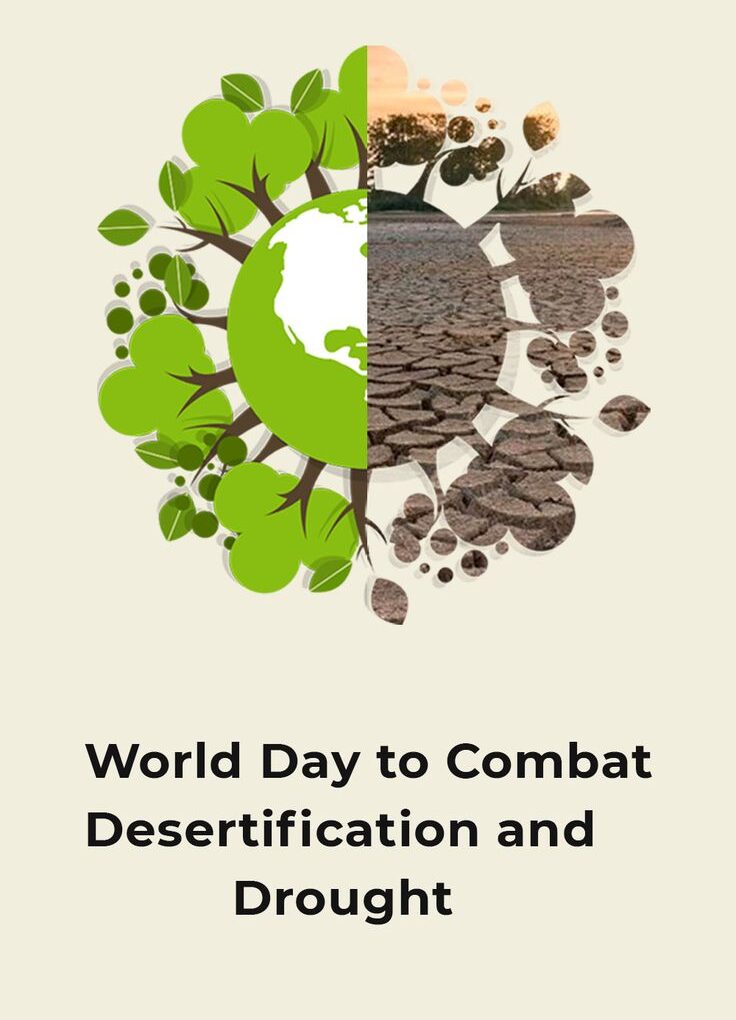World Day to Combat Desertification and Drought: A Call for Global Action
Introduction
World Day to Combat Desertification and Drought, observed every June 17, is a day dedicated to raising awareness about the global challenges posed by desertification and drought, while promoting sustainable land management practices. The day aims to remind people of the urgent need for action to prevent the degradation of land and ensure that desertification and drought do not lead to irreversible environmental damage.
Desertification refers to the process of land degradation, where fertile land becomes increasingly dry and unproductive due to various factors, including climate change, deforestation, and unsustainable agricultural practices. Drought, on the other hand, is a prolonged period of abnormally low rainfall, leading to a scarcity of water, crop failures, and the depletion of vital resources.
As our planet continues to face the growing challenges of climate change and environmental degradation, World Day to Combat Desertification and Drought serves as an important reminder to take collective action to preserve the health of our ecosystems and protect vulnerable communities.
History of World Day to Combat Desertification and Drought
The United Nations (UN) officially declared World Day to Combat Desertification and Drought in 1995, following the adoption of the UN Convention to Combat Desertification (UNCCD). This convention was designed to address the global problem of desertification and to provide a framework for the restoration and sustainable management of land in dryland areas.
The observance was established to highlight the importance of sustainable land management practices and to promote efforts to reverse land degradation. It is a day to raise global awareness about the causes and consequences of desertification and drought, while focusing on solutions that promote environmental sustainability, economic stability, and social well-being.
Facts About Desertification and Drought
- Global Land Degradation: According to the UNCCD, approximately 1.9 billion hectares of land globally are at risk of desertification. Around 75% of the Earth’s land surface is already experiencing varying degrees of degradation, putting billions of people at risk.
- Impact on Agriculture: Desertification and drought severely affect agriculture, which is the main source of livelihood for millions of people in vulnerable regions. In some areas, entire crop yields are lost due to insufficient water and poor soil quality, exacerbating food insecurity.
- Population Vulnerability: Over 2 billion people worldwide are at risk from the effects of desertification and drought, with the greatest impact being felt by rural communities in dryland areas such as parts of Africa, Asia, and Latin America. These regions are particularly vulnerable due to their reliance on agriculture and water resources.
- Climate Change Link: Desertification and drought are both exacerbated by climate change. Rising temperatures, erratic rainfall patterns, and the increasing frequency of extreme weather events contribute to the acceleration of land degradation, making the problem even more urgent.
- Loss of Biodiversity: Desertification also leads to a loss of biodiversity, as species of plants, animals, and microorganisms are unable to survive in degraded environments. This disruption to ecosystems affects not only wildlife but also the livelihoods of communities that depend on the land for their food, water, and resources.
Significance of World Day to Combat Desertification and Drought
- Raising Awareness: World Day to Combat Desertification and Drought is an important opportunity to raise global awareness about the environmental challenges posed by land degradation. It draws attention to the need for urgent action to halt desertification and combat the impact of drought on affected communities.
- Promoting Sustainable Land Management: The observance highlights the importance of sustainable land management practices, such as agroforestry, water conservation techniques, and reforestation. These practices can help restore degraded land, improve water availability, and enhance agricultural productivity, reducing the risk of desertification.
- Encouraging Global Collaboration: Tackling desertification and drought requires a collective effort. World Day to Combat Desertification and Drought encourages international collaboration to address the underlying causes of land degradation, including unsustainable agriculture, deforestation, and urbanization. It promotes the exchange of knowledge and resources to support affected regions in restoring their land.
- Empowering Communities: This day is also about empowering local communities to take action and adopt sustainable practices that can help combat desertification. Community-based initiatives, such as soil conservation, water harvesting, and sustainable farming techniques, can play a critical role in restoring degraded land and improving the resilience of local populations.
- Linking Land and Climate: World Day to Combat Desertification and Drought underscores the interconnection between land health and climate change. It emphasizes the need for climate adaptation strategies that promote land restoration and resilience in the face of increasingly unpredictable weather patterns.
Daily Life Impact of Desertification and Drought
- Agricultural Productivity: Desertification and drought have a direct impact on the daily lives of individuals living in affected regions, especially farmers. As fertile soil becomes less productive, crops fail, leading to food shortages and economic instability. Livelihoods that rely on agriculture are compromised, creating financial hardship for millions of families.
- Water Scarcity: Drought exacerbates water scarcity, affecting both personal consumption and agricultural irrigation. Water shortages lead to health problems, as access to clean drinking water becomes limited. People must adapt to using less water for daily needs, which can further impact their quality of life.
- Migration and Displacement: In severe cases, desertification and drought can force entire communities to migrate in search of better living conditions. This leads to climate-induced displacement, with people leaving their homes to seek refuge in other regions, often contributing to social, economic, and political challenges in receiving areas.
- Health and Well-being: The lack of water, poor air quality, and malnutrition resulting from desertification and drought can have detrimental effects on the health and well-being of affected populations. In particular, children and the elderly are the most vulnerable to these environmental stressors.
Observing World Day to Combat Desertification and Drought
- Raising Awareness Through Education: Schools, universities, and environmental organizations can host educational events, seminars, and workshops to teach people about the causes and effects of desertification and drought, as well as the ways they can help combat land degradation.
- Participating in Reforestation Efforts: On World Day to Combat Desertification and Drought, individuals and organizations can participate in reforestation and tree planting activities in areas affected by desertification. These actions help improve soil quality, increase biodiversity, and restore ecosystems.
- Supporting Sustainable Practices: Supporting initiatives that promote sustainable land management practices is crucial. People can choose to support businesses and organizations that are committed to sustainable agriculture, water conservation, and soil preservation.
- Advocating for Policy Change: On this day, individuals and organizations can advocate for policies that prioritize land restoration and sustainable environmental management. Governments and policymakers play a key role in creating and enforcing laws that protect the land and prevent further degradation.
Conclusion
World Day to Combat Desertification and Drought is a critical day to remind us of the urgent need for global action to address land degradation and water scarcity. Desertification and drought are not just environmental issues; they are deeply connected to social, economic, and political challenges. By raising awareness and taking action, we can contribute to creating a sustainable future where land is preserved, people thrive, and ecosystems are restored.











Access detailed information about the Audemars Piguet Royal Oak Offshore 15710ST on this site , including market values ranging from $34,566 to $36,200 for stainless steel models.
The 42mm timepiece showcases a robust design with selfwinding caliber and water resistance , crafted in titanium.
https://ap15710st.superpodium.com
Compare secondary market data , where limited editions reach up to $750,000 , alongside vintage models from the 1970s.
Get real-time updates on availability, specifications, and investment returns , with free market analyses for informed decisions.